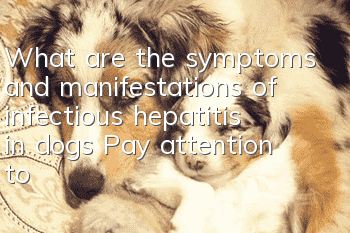What are the symptoms and manifestations of infectious hepatitis in dogs? Pay attention to distinguish it from canine distemper.

Symptoms of infectious hepatitis in dogs
The epidemic characteristic of this disease is that it can occur regardless of breed, gender, and season. It is especially common in puppies under 1 year old and in winter.1. The initial symptoms are very similar to canine distemper. The sick dog is depressed, has a loss of appetite, is thirsty, and even has its two forelimbs immersed in water and drinks heavily. This is a characteristic symptom of this disease. The body temperature of sick dogs rises to above 40 degrees Celsius and lasts for 4-6 days.
2. Vomiting and diarrhea are common. If there is blood in the vomitus and feces, the prognosis is often poor. Most sick dogs have pain in the xiphoid cartilage.
3. 7-10 days after the acute symptoms disappear, the cornea of some dogs is cloudy and appears white or bluish-white, which is called hepatitis blue eye. It disappears after a few days. There are bleeding spots on the gums. Although the disease is called hepatitis, jaundice rarely occurs. If there is no secondary infection, it usually returns to normal within a few days.
Causes of infectious hepatitis in dogs
1. The virus mainly exists in the blood of sick dogs at the beginning of the disease. Later, there are a lot of viruses in various secretions and excretions and are excreted from the body. , polluting the external environment. After recovery, toxins can be excreted in the urine for 6-9 months. Therefore, sick dogs and virus-carrying dogs are the source of infection of this disease.2. Healthy dogs are mainly infected through the digestive tract, and can also be infected through the placenta.
3. The virus has strong resistance and can survive for a long time under low temperature conditions. It can still be pathogenic in the soil for 10-14 days and can also survive for a long time in dog kennels. But heating can quickly kill the virus.
Treatment and preventive measures for canine infectious hepatitis
1. Isolate the sick dog as soon as possible and treat it with hyperimmune serum or adult dog serum, once a day, 10 to 30 ml each time. In addition, 20-40 ml of 50% glucose solution, 250 mg of vitamin C or 15-20 mg of adenosine triphosphate should be injected intravenously every day, once a day for 3-5 days. Take Gan Tai Le tablets orally.2. Drink water sparingly and feed 5% glucose saline every 2-3 hours.
3. Preventive injections. Inject canine five-part attenuated vaccine (rabies, canine distemper, parainfluenza, infectious hepatitis, parvovirus enteritis) and canine hepatitis and enteritis two-part vaccine. Dogs aged 30 to 90 days should be vaccinated three times, and dogs over 90 days old should be vaccinated twice, with an interval of 2 to 4 weeks between each time. Dosage for each injection: 2 ml for the five-in-one vaccine and 1 ml for the two-in-one vaccine, which can provide a one-year immunity period.
4. The kennel must be well sanitized, breed and raise by itself, and mixed breeding with other dogs is strictly prohibited.
Random articles
- What do dogs eat to protect their stomach? It is important to protect their stomach and treat gastrointestinal diseases in dogs.
- How to tell if your dog is fat? Is your dog overweight?
- Will your dog catch a cold if you blow the air conditioner? What should you do if your dog catches a cold if you blow the air conditioner?
- What should you pay attention to when your dog drinks water? Don’t be careless when it comes to your dog’s drinking water.
- The dog's mouth bites and shakes. Why does the dog's mouth occasionally shake and bite?
- How to cut a dog's hair? Do you know how to cut a dog's hair correctly?
- Can dogs eat raw eggs? Why can’t dogs eat egg whites?
- Common Dog Problems in Summer How to Deal with Different Dog Problems
- How to keep dogs away from skin diseases. If you do this, will you see if your dog will still be infected with skin diseases?
- What causes anorexia in dogs? Dogs will become anorexic due to lack of exercise. Hounds run at least 5KM every day.



